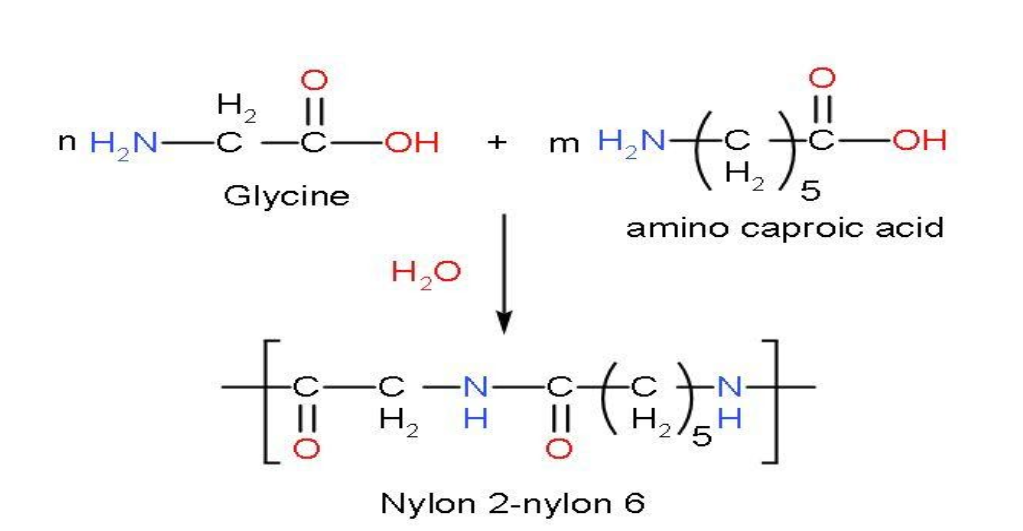
The monomers of biodegradable polymer, nylon 2-nylon 6 are:
A. glycine + adipic acid
B. glycol + phthalic acid
C. phenol + urea
D. glycine + amino caproic acid
Answer
213.9k+ views
Hint: Nylon 2-nylon 6 is a condensation polymer. It is a result of polyamide copolymerization of two monomers, one has both amino group and carboxylic acid and another is a derivative of amino acid lysine.
Complete step by step answer:
Polymerization is a process in which small molecules, known as monomers combine chemically to produce a very large network molecule which is called a polymer.
Monomers are the molecules that are bonded to other molecules to form a polymer.
There are two monomers of Nylon 2-nylon 6 named as Glycine $\left( \text{Gly} \right)$ with chemical formula $\left( {{\text{H}}_{2}}\text{NC}{{\text{H}}_{2}}\text{COOH} \right)$ and Amino caproic acid has the chemical formula $\left( {{\text{C}}_{6}}{{\text{H}}_{13}}{{\text{O}}_{2}}\text{N} \right)$. The reaction of both gives the polymer nylon 2-nylon 6 after removal of water molecules from the reactants.

A condensation polymerization is in which monomers react with each other to form larger structural units while releasing water or methanol as by-product.
Biodegradable polymers are a type of polymer that breaks down by bacterial decomposition to result in natural by-products such as gases $\left( \text{C}{{\text{O}}_{2}},{{\text{N}}_{2}} \right)$, water and biomass.
The correct answer of this question is the monomers of biodegradable polymer, nylon 2-nylon 6 are glycine and amino caproic acid.
option ‘d’ is correct
Additional Information:
Applications of Nylon 2-nylon 6 are:
(1) It is used in synthesis of artificial fibers.
(2) Used to make strings of musical instruments and threads in bristles for toothbrushes.
Note:
Glycine is the only achiral amino acid. As glycine has two groups attached to it as the same which is two hydrogen atoms are attached to it. But the coming compounds of amino acids groups will have one hydrogen atom to be replaced with other groups. Like, Alanine has methyl group instead of hydrogen atom; $\text{C}{{\text{H}}_{3}}\text{CHN}{{\text{H}}_{2}}\text{COOH}$.
Complete step by step answer:
Polymerization is a process in which small molecules, known as monomers combine chemically to produce a very large network molecule which is called a polymer.
Monomers are the molecules that are bonded to other molecules to form a polymer.
There are two monomers of Nylon 2-nylon 6 named as Glycine $\left( \text{Gly} \right)$ with chemical formula $\left( {{\text{H}}_{2}}\text{NC}{{\text{H}}_{2}}\text{COOH} \right)$ and Amino caproic acid has the chemical formula $\left( {{\text{C}}_{6}}{{\text{H}}_{13}}{{\text{O}}_{2}}\text{N} \right)$. The reaction of both gives the polymer nylon 2-nylon 6 after removal of water molecules from the reactants.

A condensation polymerization is in which monomers react with each other to form larger structural units while releasing water or methanol as by-product.
Biodegradable polymers are a type of polymer that breaks down by bacterial decomposition to result in natural by-products such as gases $\left( \text{C}{{\text{O}}_{2}},{{\text{N}}_{2}} \right)$, water and biomass.
The correct answer of this question is the monomers of biodegradable polymer, nylon 2-nylon 6 are glycine and amino caproic acid.
option ‘d’ is correct
Additional Information:
Applications of Nylon 2-nylon 6 are:
(1) It is used in synthesis of artificial fibers.
(2) Used to make strings of musical instruments and threads in bristles for toothbrushes.
Note:
Glycine is the only achiral amino acid. As glycine has two groups attached to it as the same which is two hydrogen atoms are attached to it. But the coming compounds of amino acids groups will have one hydrogen atom to be replaced with other groups. Like, Alanine has methyl group instead of hydrogen atom; $\text{C}{{\text{H}}_{3}}\text{CHN}{{\text{H}}_{2}}\text{COOH}$.
Recently Updated Pages
Chemical Equation - Important Concepts and Tips for JEE

JEE Main 2022 (July 29th Shift 1) Chemistry Question Paper with Answer Key

Conduction, Transfer of Energy Important Concepts and Tips for JEE

JEE Analytical Method of Vector Addition Important Concepts and Tips

Atomic Size - Important Concepts and Tips for JEE

JEE Main 2022 (June 29th Shift 1) Maths Question Paper with Answer Key

Trending doubts
JEE Main 2026: Application Form Open, Exam Dates, Syllabus, Eligibility & Question Papers

JEE Main Correction Window 2026 Session 1 Dates Announced - Edit Form Details, Dates and Link

Equation of Trajectory in Projectile Motion: Derivation & Proof

JEE Main 2026 Application Login: Direct Link, Registration, Form Fill, and Steps

Hybridisation in Chemistry – Concept, Types & Applications

Angle of Deviation in a Prism – Formula, Diagram & Applications

Other Pages
NCERT Solutions For Class 12 Chemistry Chapter 1 Solutions - 2025-26

NCERT Solutions for Class 12 Chemistry Chapter Chapter 7 Alcohol Phenol and Ether

NCERT Solutions ForClass 12 Chemistry Chapter Chapter 8 Aldehydes Ketones And Carboxylic Acids

JEE Advanced Marks vs Ranks 2025: Understanding Category-wise Qualifying Marks and Previous Year Cut-offs

Haloalkanes and Haloarenes Class 12 Chemistry Chapter 6 CBSE Notes - 2025-26

Solutions Class 12 Chemistry Chapter 1 CBSE Notes - 2025-26




